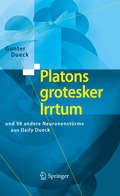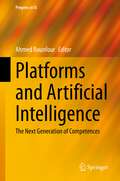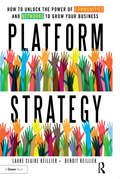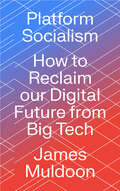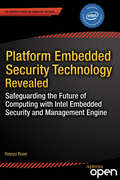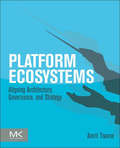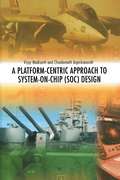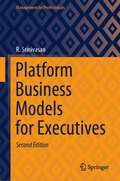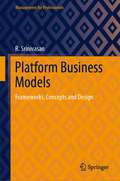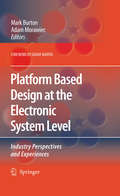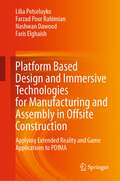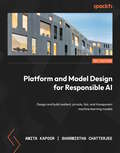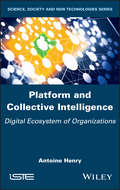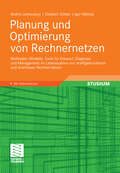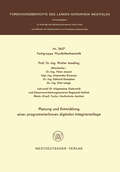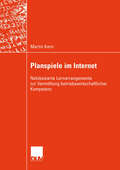- Table View
- List View
Plattform-Geschäftsmodelle: Rahmenwerke, Konzepte und Design
by R. SrinivasanDieses Buch stellt Plattformfirmen als einzigartige Geschäftsmodelle vor. Unter Rückgriff auf die frühe Literatur zur Netzwerkökonomie und zu Strategiekonzepten untersucht dieses Buch, wie sich Plattformunternehmen in der modernen Geschäftswelt entwickeln. Aus einer strategischen Perspektive heraus vermittelt dieses Buch dem Leser Kernkonzepte, Fallstudien und Rahmenwerke zur Analyse von Plattformunternehmen. Das Buch unterscheidet Plattformunternehmen von traditionellen Pipeline-Firmen; es untersucht das Engagement mit verschiedenen Akteuren, die Wertschöpfung und den Betrieb von Plattformen; es erläutert die Ressourcen und Fähigkeiten von Plattformunternehmen, die ihnen einen nachhaltigen Wettbewerbsvorteil verschaffen; es analysiert die Leistungshebel beim Betrieb von Plattformgeschäftsmodellen, einschließlich der Komplementarität mit anderen Geschäftsmodellen; und es erörtert die Nachhaltigkeit von Plattformgeschäftsmodellen, unter anderem angesichts regulatorischer und gesellschaftlicher Herausforderungen.Das Buch ist als Leitfaden für Unternehmer gedacht, die Plattformunternehmen gründen und betreiben, für Führungskräfte in großen Unternehmen, die ihre Ressourcen umwidmen, um die Netzwerkdynamik in ihren Unternehmen in Gang zu setzen, für Nachwuchsführungskräfte und für Fachleute, die für ihre beruflichen und persönlichen Bedürfnisse mit unzähligen Plattformunternehmen zusammenarbeiten. Dieses Buch soll Entscheidungsträgern ein Portfolio von Entscheidungen an die Hand geben, die sie treffen müssen, um eine Plattformfirma zu gründen, zu betreiben, aufrechtzuerhalten und aus ihr Wert zu schöpfen. Es ist auch für Fachleute aus der Politik nützlich, um die wirtschaftlichen und politischen Implikationen der Regulierung und Steuerung von Plattformen in einer postdigitalen Welt zu verstehen.
Platons grotesker Irrtum: und 98 andere Neuronenstürme aus Daily Dueck
by Gunter DueckSeit 2005 schreibt der Bestsellerautor Gunter Dueck auf seiner Hompepage www.omnisophie.com alle 14 Tage ein neues „Daily Dueck". Mehr als 5000 Stammleser finden dort Satirisches, Ergötzliches oder auch herb Kritisches. Der Band versammelt die ersten 99 „Daily Duecks" für diejenigen, die lieber ein Buch in den Händen halten möchten. Dueck warnte schon früh vor der Finanzkrise, er schreibt witzige oder ätzend scharfe Pointen über Heuschrecken, treudoofe Bestandskunden, Arbeitsstress und Werteverluste und wirbt für mehr Vertrauen im Arbeitsleben.
Platforms and Artificial Intelligence: The Next Generation of Competences (Progress in IS)
by Ahmed BounfourArtificial intelligence (AI) and platforms are closely related. Most investments in AI, especially in critical technologies, are provided by large platforms. This book describes how platforms invest in AI and how AI will impact the next generation of competences, following a twofold approach to do so: on the one hand, the book seeks to understand how platforms for investment in intangibles and AI are organized, but on the other hand, it provides a framework to describe how AI will change jobs and competences in the future.Moreover, the book addresses five main themes: 1. platforms, platformization, and the foundations of their business models; 2. artificial intelligence, technological tendencies, and the policy agenda; 3. artificial intelligence, productivity, and the next generation of competences; 4. artificial intelligence, productivity, and the digital divide; 5. artificial intelligence, ethics, and the post-truth society.The book’s content is mostly based on papers presented at the last two installments of the World Conference on Intellectual Capital for Communities. It brings together the views of leading scholars and experts on how artificial intelligence and platformization will impact competences in the near future.
Platform Strategy: How to Unlock the Power of Communities and Networks to Grow Your Business
by Laure Claire Reillier Benoit ReillierDuring the last decade, platform businesses such as Uber, Airbnb, Amazon and eBay have been taking over the world. In almost every sector, traditional businesses are under attack from digital disrupters that are effectively harnessing the power of communities. But what exactly is a platform business and why is it different? In Platform Strategy, Laure Claire Reillier and Benoit Reillier provide a practical guide for students, digital entrepreneurs and executives to understand what platforms are, how they work and how you can build one successfully. Using their own "rocket model" and original case studies (including Google, Apple, Amazon), they explain how designing, igniting and scaling a platform business requires learning a whole new set of management rules. Platform Strategy also offers many fascinating insights into the future of platforms, their regulation and governance, as well as how they can be combined with other business models. Benoit Reillier and Laure Claire Reillier are co-founders of Launchworks, a leading advisory firm focused on helping organizations develop and scale innovative business models.
Platform Strategy: How to Unlock the Power of Communities and Networks to Grow Your Business
by Laure Claire Reillier Benoit ReillierDuring the last decade, platform businesses such as Uber, Airbnb, Amazon and eBay have been taking over the world. In almost every sector, traditional businesses are under attack from digital disrupters that are effectively harnessing the power of communities. But what exactly is a platform business and why is it different? In Platform Strategy, Laure Claire Reillier and Benoit Reillier provide a practical guide for students, digital entrepreneurs and executives to understand what platforms are, how they work and how you can build one successfully. Using their own "rocket model" and original case studies (including Google, Apple, Amazon), they explain how designing, igniting and scaling a platform business requires learning a whole new set of management rules. Platform Strategy also offers many fascinating insights into the future of platforms, their regulation and governance, as well as how they can be combined with other business models. Benoit Reillier and Laure Claire Reillier are co-founders of Launchworks, a leading advisory firm focused on helping organizations develop and scale innovative business models.
Platform Socialism: How to Reclaim our Digital Future from Big Tech
by James Muldoon'Ground-breaking and ambitious' - Nick Srnicek, author of Platform Capitalism Whoever controls the platforms, controls the future. Platform Socialism sets out an alternative vision and concrete proposals for a digital economy that expands our freedom. Powerful tech companies now own the digital infrastructure of twenty-first century social life. Masquerading as global community builders, these companies have developed sophisticated new techniques for extracting wealth from their users. James Muldoon shows how grassroots communities and transnational social movements can take back control from Big Tech. He reframes the technology debate and proposes a host of new ideas, from the local to the international, for how we can reclaim the emancipatory possibilities of digital platforms. Drawing on sources from forgotten histories to contemporary prototypes, he proposes an alternative system and charts a roadmap for how we can get there.
Platform Socialism: How to Reclaim our Digital Future from Big Tech
by James Muldoon'Ground-breaking and ambitious' - Nick Srnicek, author of Platform Capitalism Whoever controls the platforms, controls the future. Platform Socialism sets out an alternative vision and concrete proposals for a digital economy that expands our freedom. Powerful tech companies now own the digital infrastructure of twenty-first century social life. Masquerading as global community builders, these companies have developed sophisticated new techniques for extracting wealth from their users. James Muldoon shows how grassroots communities and transnational social movements can take back control from Big Tech. He reframes the technology debate and proposes a host of new ideas, from the local to the international, for how we can reclaim the emancipatory possibilities of digital platforms. Drawing on sources from forgotten histories to contemporary prototypes, he proposes an alternative system and charts a roadmap for how we can get there.
Platform Embedded Security Technology Revealed: Safeguarding the Future of Computing with Intel Embedded Security and Management Engine
by Xiaoyu RuanPlatform Embedded Security Technology Revealed is an in-depth introduction to Intel’s platform embedded solution: the security and management engine. The engine is shipped inside most Intel platforms for servers, personal computers, tablets, and smartphones. The engine realizes advanced security and management functionalities and protects applications’ secrets and users’ privacy in a secure, light-weight, and inexpensive way. Besides native built-in features, it allows third-party software vendors to develop applications that take advantage of the security infrastructures offered by the engine. Intel’s security and management engine is technologically unique and significant, but is largely unknown to many members of the tech communities who could potentially benefit from it. Platform Embedded Security Technology Revealed reveals technical details of the engine. The engine provides a new way for the computer security industry to resolve critical problems resulting from booming mobile technologies, such as increasing threats against confidentiality and privacy. This book describes how this advanced level of protection is made possible by the engine, how it can improve users’ security experience, and how third-party vendors can make use of it. It's written for computer security professionals and researchers; embedded system engineers; and software engineers and vendors who are interested in developing new security applications on top of Intel’s security and management engine.It’s also written for advanced users who are interested in understanding how the security features of Intel’s platforms work.
Platform Ecosystems: Aligning Architecture, Governance, and Strategy
by Amrit TiwanaPlatform Ecosystems is a hands-on guide that offers a complete roadmap for designing and orchestrating vibrant software platform ecosystems. Unlike software products that are managed, the evolution of ecosystems and their myriad participants must be orchestrated through a thoughtful alignment of architecture and governance. Whether you are an IT professional or a general manager, you will benefit from this book because platform strategy here lies at the intersection of software architecture and business strategy. It offers actionable tools to develop your own platform strategy, backed by original research, tangible metrics, rich data, and cases. You will learn how architectural choices create organically-evolvable, vibrant ecosystems. You will also learn to apply state-of-the-art research in software engineering, strategy, and evolutionary biology to leverage ecosystem dynamics unique to platforms. Read this book to learn how to: Evolve software products and services into vibrant platform ecosystemsOrchestrate platform architecture and governance to sustain competitive advantageGovern platform evolution using a powerful 3-dimensional framework If you’re ready to transform platform strategy from newspaper gossip and business school theory to real-world competitive advantage, start right here!Understand how architecture and strategy are inseparably intertwined in platform ecosystems Architect future-proof platforms and apps and amplify these choices through governance Evolve platforms, apps, and entire ecosystems into vibrant successes and spot platform opportunities in almost any—not just IT—industry
A Platform-Centric Approach to System-on-Chip (SOC) Design
by Vijay Madisetti Chonlameth ArpnikanondtIncreasing system complexity has created a pressing need for better design tools and associated methodologies and languages for meeting the stringent time to market and cost constraints. Platform-centric and platfo- based system-on-chip (SoC) design methodologies, based on reuse of software and hardware functionality, has also gained increasing exposure and usage within the Electronic System-Level (ESL) design communities. The book proposes a new methodology for realizing platform-centric design of complex systems, and presents a detailed plan for its implementation. The proposed plan allows component vendors, system integrators and product developers to collaborate effectively and efficiently to create complex products within budget and schedule constraints. This book focuses more on the use of platforms in the design of products, and not on the design of platforms themselves. Platform-centric design is not for everyone, as some may feel that it does not allow them to differentiate their offering from competitors to a significant degree. However, its proponents may claim that the time-- market and cost advantages of platform-centric design more than compensate for any drawbacks.
Platform Business Models for Executives (Management for Professionals)
by R. SrinivasanThis book takes a practice approach to studying platform business models. Drawing from the growing academic literature as well as the practice world, this book intends to provide a framework for analysing platform business firms. Leveraging on the early literature on network economics (that was largely analytical) and the popular writing about new organizations, this book takes a strategic perspective. It answers the five big strategy questions about platform business firms: a. What are platform business models, and how are they different from others; b. How do platform business firms operate, and what value do they create? To whom and how; c. What are those resources that platforms possess and leverage to create and sustain their competitive advantage over others; d. Why and how are they successful? Why do they perform differently from others? What metrics of performance should we use to study and analyse their performance; e. Is this business model sustainable? What determines the longevity of such firms? What are the regulatory and social challenges that these platform business firms face? How do regulators and the larger society manage the disproportionate power distribution among such firms?The book is strategic in nature and highlights the resources defining the strategies of successful platform business firms. In doing so, it provides a field guide for entrepreneurs and managers embarking on building a platform, by providing a portfolio of decisions to make. Though the frameworks could be generalized, the book focuses on platform businesses, rather than societal platforms. With a few extensions, it is possible that these frameworks could be easily applied to non-profit and or social enterprises as well.
Platform Business Models: Frameworks, Concepts and Design (Management for Professionals)
by R. SrinivasanThis book introduces platform firms as unique business models. Leveraging on the early literature on network economics and strategy frameworks, this book explores how platform business firms evolve in the modern business world. Taking a strategic perspective, this book engages the reader with core concepts, case studies, and frameworks for analyzing platform business firms. This book differentiates platform business firms from traditional pipeline firms; explores engagement with different actors, value creation, and operations of platforms; elucidates resources and capabilities of platform firms that provide them sustained competitive advantage; analyzes performance levers in operating platform business models, including complementarities with other business models; and discusses the sustainability of platform business models, in the face of regulatory and societal challenges, among others. The book is designed as a primer for entrepreneurs setting up and operating platform business firms, senior managers in large corporations repurposing their resources to initiate network dynamics in their businesses, early career managers, and professionals engaging with myriad platform firms for their professional and personal needs. This book intends to provide a decision-maker with a portfolio of decisions to make to create, operate, sustain, and generate value out of a platform business firm. It is also useful for policy professionals to appreciate the economics and policy implications of regulating and governing platforms in a post-digital world.
Platform Based Design at the Electronic System Level: Industry Perspectives and Experiences
by Mark Burton Adam MorawiecPlatform Based Design at the Electronic System Level presents a multi-faceted view of the challenges facing the electronic industry in the development and integration of complex heterogeneous systems, including both hardware and software components. It analyses and proposes solutions related to the provision of integration platforms by System on Chip and Integrated Platform providers in light of the needs and requirements expressed by the system companies: they are the users of such platforms, which they apply to develop their next-generation products. This is the first book to examine ESL from perspectives of system developer, platform provider and Electronic Design Automation.
Platform Based Design and Immersive Technologies for Manufacturing and Assembly in Offsite Construction: Applying Extended Reality and Game Applications to PDfMA
by Lilia Potseluyko Farzad Pour Rahimian Nashwan Dawood Faris ElghaishThis book explores the applications of virtual reality technologies in building design and offsite construction. Its focus is on how small and medium-sized architectural and construction practices with limited budgets and time can implement innovation through visualisation creation. Virtual reality technologies, known as empathy machines, offer a productive interaction process for clients and professionals. Gaming and simulation have already proven their efficacy in solving problems in science and business. However, the next challenge is designing data-rich virtual environments that can enhance clients' spatial understanding, simplify architect-client communications, provide customisation options, consolidate quantification, and export data directly to manufacturers' software, minimizing fragmentation across the entire building information management (BIM) lifecycle.With this book, architects and construction professionals can learn how to leverage virtual reality technologies to improve their work processes and enhance client engagement. Whether you're new to virtual reality or an experienced practitioner, this book provides valuable insights and practical tips to help you harness the power of this exciting technology.With this book, architects and construction professionals can learn how to leverage virtual reality technologies to improve their work processes and enhance client engagement. Whether you're new to virtual reality or an experienced practitioner, this book provides valuable insights and practical tips to help you harness the power of this exciting technology.With this book, architects and construction professionals can learn how to leverage virtual reality technologies to improve their work processes and enhance client engagement. Whether you're new to virtual reality or an experienced practitioner, this book provides valuable insights and practical tips to help you harness the power of this exciting technology.With this book, architects and construction professionals can learn how to leverage virtual reality technologies to improve their work processes and enhance client engagement. Whether you're new to virtual reality or an experienced practitioner, this book provides valuable insights and practical tips to help you harness the power of this exciting technology.With this book, architects and construction professionals can learn how to leverage virtual reality technologies to improve their work processes and enhance client engagement. Whether you're new to virtual reality or an experienced practitioner, this book provides valuable insights and practical tips to help you harness the power of this exciting technology.With this book, architects and construction professionals can learn how to leverage virtual reality technologies to improve their work processes and enhance client engagement. Whether you're new to virtual reality or an experienced practitioner, this book provides valuable insights and practical tips to help you harness the power of this exciting technology.With this book, architects and construction professionals can learn how to leverage virtual reality technologies to improve their work processes and enhance client engagement. Whether you're new to virtual reality or an experienced practitioner, this book provides valuable insights and practical tips to help you harness the power of this exciting technology.With this book, architects and construction professionals can learn how to leverage virtual reality technologies to improve their work processes and enhance client engagement. Whether you're new to virtual reality or an experienced practitioner, this book provides valuable insights and practical tips to help you harness the power of this exciting technology.With this book, architects and construction professionals can learn how to leverage virtual reality technologies to improve their work processes and enhance client engagement. Wh
Platform and Model Design for Responsible AI: Design and build resilient, private, fair, and transparent machine learning models
by Amita Kapoor Sharmistha ChatterjeeAI algorithms are ubiquitous and used for tasks, from recruiting to deciding who will get a loan. With such widespread use of AI in the decision-making process, it’s necessary to build an explainable, responsible, transparent, and trustworthy AI-enabled system. With Platform and Model Design for Responsible AI, you’ll be able to make existing black box models transparent. You’ll be able to identify and eliminate bias in your models, deal with uncertainty arising from both data and model limitations, and provide a responsible AI solution. You’ll start by designing ethical models for traditional and deep learning ML models, as well as deploying them in a sustainable production setup. After that, you’ll learn how to set up data pipelines, validate datasets, and set up component microservices in a secure and private way in any cloud-agnostic framework. You’ll then build a fair and private ML model with proper constraints, tune the hyperparameters, and evaluate the model metrics. By the end of this book, you’ll know the best practices to comply with data privacy and ethics laws, in addition to the techniques needed for data anonymization. You’ll be able to develop models with explainability, store them in feature stores, and handle uncertainty in model predictions.Key FeaturesLearn risk assessment for machine learning frameworks in a global landscapeDiscover patterns for next-generation AI ecosystems for successful product designMake explainable predictions for privacy and fairness-enabled ML trainingWhat you will learnUnderstand the threats and risks involved in ML modelsDiscover varying levels of risk mitigation strategies and risk tiering toolsApply traditional and deep learning optimization techniques efficientlyBuild auditable and interpretable ML models and feature storesUnderstand the concept of uncertainty and explore model explainability toolsDevelop models for different clouds including AWS, Azure, and GCPExplore ML orchestration tools such as Kubeflow and Vertex AIIncorporate privacy and fairness in ML models from design to deploymentWho this book is forThis book is for experienced machine learning professionals looking to understand the risks and leakages of ML models and frameworks, and learn to develop and use reusable components to reduce effort and cost in setting up and maintaining the AI ecosystem.
Platform and Collective Intelligence: Digital Ecosystem of Organizations
by Antoine HenryOrganizations, both private and public, are now evolving in a globalized "information society" that has been accelerated by digitization. They find themselves drawn into a spiral of transformations fueled by the incessant reinvention of information and communication technologies (ICT) that are changing digital uses and practices. They transform through the mediating action of ICTs, work activities and associated action situations. Platform and Collective Intelligence analyzes a specific declination of an organization that has become irreversibly reticular: the "platform organization". The network, at the heart of this new conception, proposes a model combining cybernetics and computing. The organization can thus be seen as an interface for contact, via its information systems, for employees or citizens, whatever their geographical location. With a view going beyond technocentrism and technological determinism, this book combines collective intelligence and sociotechnics with the platform to arrive at the notion of "organizational experience".
Platform and Collective Intelligence: Digital Ecosystem of Organizations
by Antoine HenryOrganizations, both private and public, are now evolving in a globalized "information society" that has been accelerated by digitization. They find themselves drawn into a spiral of transformations fueled by the incessant reinvention of information and communication technologies (ICT) that are changing digital uses and practices. They transform through the mediating action of ICTs, work activities and associated action situations. Platform and Collective Intelligence analyzes a specific declination of an organization that has become irreversibly reticular: the "platform organization". The network, at the heart of this new conception, proposes a model combining cybernetics and computing. The organization can thus be seen as an interface for contact, via its information systems, for employees or citizens, whatever their geographical location. With a view going beyond technocentrism and technological determinism, this book combines collective intelligence and sociotechnics with the platform to arrive at the notion of "organizational experience".
Plate Tectonics: Discover how our planet works from the inside out (The Ladybird Expert Series)
by Iain StewartPart of the ALL-NEW Ladybird Expert series.Discover in this accessible and authoritative introduction the fundamental theory of how our dynamic planet works. Written by the celebrated geologist, academic and popular science presenter Iain Stewart, Plate Tectonics explores the Earth as a planetary machine and investigates the people and ideas that changed the way we look at the world. You'll learn about the make up of the Earth in the past and the present, from monsoon-like currents in our planet's radioactive interior to magnetic force lines and what the planet would look like without water.- Our planet as an active living system- The planetary force field - Fault lines that cross continents- How plates tectonics protects life on Earth - And much more . . . Written by the leading lights and most outstanding communicators in their fields, the Ladybird Expert books provide clear, accessible and authoritative introductions to subjects drawn from science, history and culture. For an adult readership, the Ladybird Expert series is produced in the same iconic small hardback format pioneered by the original Ladybirds. Each beautifully illustrated book features the first new illustrations produced in the original Ladybird style for nearly forty years.
Plasticity and Fracture (Solid Mechanics and Its Applications #244)
by Wolfgang BrocksThis book is based on 40 years of research and teaching in the fields of fracture mechanics and plasticity. It will bring students and engineers from various disciplines up to date on key concepts that have become increasingly important in the design of safety-relevant engineering structures in general and in modern lightweight structures in the transportation industry in particular. Primarily intended for graduate students in the engineering sciences and practicing structural engineers, it employs a multidisciplinary approach that comprises theoretical concepts, numerical methods, and experimental techniques. In addition, it includes a wealth of analytical and numerical examples, used to illustrate the applications of the concepts discussed.
Planungs- und Kontrollsysteme: Informationstechnische Perspektiven für das Controlling. Grundlagen — Instrumente — Konzepte
by Friederike WallDer Schwerpunkt des Buches liegt auf der integrierenden Sichtweise von Planung und Kontrolle (PuK), Organisation und Informationstechnologie (IT). Wiederholungs- und Vertiefungsfragen am Ende eines jeden Kapitels ermöglichen dem Leser eine gezielte und systematische Aufarbeitung des behandelten Lernstoffs.
Planung von Fertigungssystemen unterstützt durch Wirtschaftlichkeitssimulation (iwb Forschungsberichte #59)
by Ulrich DillingPlanung und Optimierung von Rechnernetzen: Methoden, Modelle, Tools für Entwurf, Diagnose und Management im Lebenszyklus von drahtgebundenen und drahtlosen Rechnernetzen
by Andriy Luntovskyy Dietbert Gütter Igor MelnykModerne kombinierte Computernetze in Gebäuden, wie beispielsweise WLAN oder WSN sind sehr komplex. Eine sorgfältige Netzwerkplanung vermeidet Entwurfsfehler und trägt damit zur Verhinderung unnötiger Übertragungsengpässe und kostspieliger Veränderungsarbeiten bei. Das von den Autoren entwickelte CAD System CANDY Framework bietet einen integrierten Ansatz für die relevanten Planungsaktivitäten im Lebenszyklus von Rechnernetzen. Es stellt eine einheitliche Plattform dar, die aus mehreren Tools für unterschiedliche Aufgabenbereiche besteht. Das Lehrbuch beinhaltet einen bedeutsamen Umfang von gut bewährten theoretischen und aktuellen praktischen Lerninhalten. Moderne Projektierungsmethoden und -tools für kombinierte drahtlose Kommunikations- und Automatisierungsnetze (Wi-Fi, WiMAX, WSN) mit Festnetzstrecken (Ethernet) werden veranschaulicht. Im Buch wird außerdem zahlreiche aussagekräftige und umfangreiche Beispiele der Planung und Optimierung drahtloser Kommunikations- und Automatisierungsnetze (Wi-Fi, WiMAX, WSN) u.a. unter Nutzung von MATLAB eingeführt.
Planung und Entwicklung einer programmierbaren digitalen Integrieranlage (Forschungsberichte des Landes Nordrhein-Westfalen #2607)
by Walter AmelingPlanung koordinierter Wertschöpfungspartnerschaften
by Jörg Becker Torben Bernhold Ralf Knackstedt Martin MatznerDieses Buch stellt mit dem Cooperation-Experience-Ansatz miteinander verknüpfte Methoden und (Software-)Werkzeuge vor, die für das Kooperationsmanagement in der Konzeptionsphase wertvolle Hilfsmittel bieten. Der Ansatz umfasst ein Workshop-Konzept zur Etablierung gemeinschaftlicher Handlungsgrundlagen, eine Modellierungsmethode zur visuellen Planung der Kooperation, Softwareprototypen für die Modellierung und zum frühzeitigen „Erfahren der Kooperationen“ sowie ein Referenzmodell, das speziell für den Bau und Betrieb von Gebäuden adaptierbare Bausteine für die Konzeption eines Wertschöpfungsnetzwerkes beinhaltet.
Planspiele im Internet: Netzbasierte Lernarrangements zur Vermittlung betriebswirtschaftlicher Kompetenz (Wirtschaftsinformatik)
by Martin KernMartin Kern analysiert den planspielspezifischen Lernprozess sowie die Potentiale und Probleme eines internetbasierten Planspieleinsatzes, formuliert Anforderungen an netzbasierte Planspiel-Lernarrangements (NPL) in didaktischer, kommunikationstechnischer und technologischer Hinsicht und entwickelt konkrete Gestaltungsempfehlungen für NPLs.

